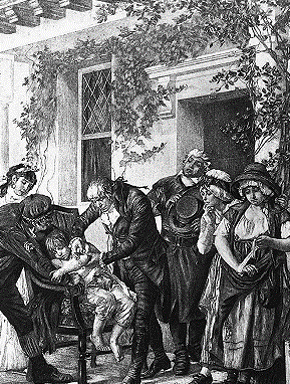Vaccines
Immunization primes the adaptive immune system to produce an immune response without actually being infected. Weakened or killed pathogens or antigenic components of a pathogen are administered to evoke a primary immune response of the adaptive immune system. This initial exposure to the antigens of an infectious agent trigger a typical immune response. Most of the immune response rapidly diminishes after a vaccination, but some lymphocytes persist with an immunologic memory. As a result, if the same pathogen infects a vaccinated person at a later date, the memory cells rapidly spring into action and trigger a much more rapid adaptive immune response than occurred with the primary exposure.
The Chinese used "variolation" - exposing uninfected individuals to matter from smallpox lesions – to prevent smallpox. Pus from a smallpox lesion could be placed under the skin with a needle. Dried, powdered scabs from smallpox lesions could be inhaled or placed in a vein with a needle.
Lady Mary Wortley Montagu, wife of the British Ambassador to Turkey, observed this method in the early 1700s and brought it back to England. Results ranged from a mild illness (most) to death (a few); mortality & morbidity from smallpox was certainly lower with variolation.
Edward Jenner was interested when a milkmaid told him she could not catch smallpox because she had had cowpox; he noted that many of the milk maids did not get smallpox. (They were renowned for their unblemished skin.) In 1796 he infected a young boy with cowpox, allowed him to fully recover, and then intentionally injected the boy with pus from a smallpox lesion.

The boy did not become ill. Jenner published a book and people began intentionally infecting themselves with cowpox. It was called "vaccination," after "vacca," the Latin word for cow, and the substance used to vaccinate was called a "vaccine."
Immune Memory
Most of the lymphocytes produced in a primary immune response are involved in fighting the pathogens, but as the clone of lymphocytes expands a few thousand of them differentiate into memory cells which persist for months or years. If the same pathogen invades the organism again, the memory cells will again bind to the pathogen and begin to replicate, but memory cells can replicate more quickly. As a result, a secondary exposure to a given antigen triggers an immune response that is much more rapid and more vigorous than that seen with the first exposure.
 .
.
Types of Vaccine
- "Inactivated" or "killed" vaccines that use formalin to kill the agent, e.g. typhoid vaccine or Salk poliomyelitis vaccine.
- "Acellular" vaccines" created with antigenic parts of the infectious agent, e.g. the capsule, flagella, or proteins from the cell wall of bacteria. These cannot induce disease, and are safe for immunocompromised people. Example: Hemophilus influenza B vaccine. Neither killed nor acellular vaccines induce strong immune responses and may require a "booster" every few years.
- "Attenuated vaccines" made from infectious agents weakened by aging or by altering its growth conditions. These tend to be the most successful vaccines, because they multiply in the body causing a greater immune response & may not require boosters. However, live, attenuated vaccines are riskier, since they can mutate back to the virulent form. Therefore, not recommended for immunocompromised patients. Examples: measles, mumps, & rubella vaccines.
- Vaccines made from toxins. The toxin is converted into a harmless "toxoid" by treating it with aluminum. Diphtheria & tetanus vaccines are toxoids. These often induce low level immune responses and are sometimes given with an "adjuvant" - an agent that increases the immune response. For example, diphtheria and tetanus vaccines are often combined with pertussis vaccine and given together as a DPT immunization. The pertussis acts as an adjuvant in this vaccine. When more than one vaccine is administered together it is called a "conjugated vaccine." Toxoid vaccines may require booster doses.
- Vaccines from similar organisms that do not cause serious disease (e.g. Jenner used cowpox vs. smallpox. BCG vaccine used to protect against Mycobacterium tuberculosis is an attenuated strain of Mycobacterium bovis and requires boosters every 3 - 4 years.
- "Subunit vaccines": Genes that encode for subunits of the infectious agent are isolated and inserted into bacteria or yeast cells that produce large quantities of subunit molecules by transcribing and translating the inserted foreign DNA. These are isolated, purified, and used as a vaccine. Example: Hepatitis B vaccine. These are safe for immunocompromised patients because they cannot cause the disease.


